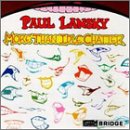| All Artists: Paul Lansky Title: More Than Idle Chatter Members Wishing: 1 Total Copies: 0 Label: Bridge Release Date: 9/20/1994 Genres: New Age, Classical Styles: Instruments, Electronic Number of Discs: 1 SwapaCD Credits: 1 UPC: 090404905025 |
Search - Paul Lansky :: More Than Idle Chatter
 | Paul Lansky More Than Idle Chatter Genres: New Age, Classical
|
Larger Image |
CD Details |
CD ReviewsNot a great deal more than idle chatter Steve Benner | Lancaster, UK | 04/10/2001 (3 out of 5 stars) "This collection of Paul Lansky's `Idle Chatter' pieces dates from 1995, and includes the first three of the series: "Idle Chatter" (1985), "just_more_idle_chatter" (1987) and "Notjustmoreidlechatter" (1988). There has in fact been at least one further addition to the series since this release: "Idle Chatter Junior" came along in 1999. These tape works have been amusing computer-music aficionados for years; having the first three together at last on this one CD makes for an interesting contrast. All were created from vocal fragments, together with other similar computer-generated sounds, produced by the application of linear predictive coding, as well as granular synthesis techniques. The sound elements were stochastically (re)assembled by means of a computer program, producing, in all three cases, a confused and confusing babble of singing voices, from which the listener constantly tries to deduce meaning but where, in fact, there is simply none to be found! Each of these vocal melees involves a boppy but complex series of rhythms and harmonic shifts that, whilst constantly evolving, ultimately never actually make it anywhere. The overall effect is rather more reminiscent of Jean Michel Jarre of the "Zoolook" period - albeit a Jarre on acid - than something one might expect of the serious American computer-music avant-garde! But while these works may be amusing on a first hearing, I am not sure that they really stand up to any repeated listening thereafter. Also, with each being around the 8- or 9-minute mark, I can't help feeling that most listeners will consider them to have exhausted their musical potential well before their end. On this CD, the three `Idle Chatter' pieces are sensibly divided from each other by three of Lansky's other vocal explorations. These provide an interesting contrast to the relentless babbling of the `Idle Chatter' works, even though they share a common point of origin with them (and with each other) through the use of fragments of speech as source material. Here, however, whole words and phrases are used, often subjected to a light processing by computer, in an attempt, the composer claims, to emphasise "the music in speech". Mostly, this processing is simply the application of a comb-filter; some listeners may tire quite quickly of this effect. Heard individually, though, these works probably stand up slightly better to repeated listening than their companion pieces."Word Color" (1992) uses a collection of arbitrary words (plus a chunk of Whitman poetry) to trigger sonic resonances within the listener's memory. In contrast, "The Lesson" (1989) uses sentences taken from just one side of a taped discussion and assembled in a shuffled order, pointing up the music of spoken vocal patterns, by partially divorcing the words and phrases from their originally intended meaning. By far the most effective work, however, is the final track, "Memory Pages", composed in 1993. This is the only work to feature somewhat richer sonic material, with an opening insect-sound accompaniment and an overall sonic depth which delves beyond that of ringing comb-filters (although that effect is still present). The work uses an evocative series of recollections spoken by both the composer and his wife (actress Hannah MacKay, who is also the source of much of the other vocal material on the disc) to paint an involving music study of past experiences relived through their retelling.I'm not entirely sure how often most listeners would wish to relive the musical experiences contained on this disc; they are more intellectually interesting than emotionally engaging. This nevertheless remains an important release, which should be of interest to all serious collectors of late 20th century computer music."
|

 Track Listings (6) - Disc #1
Track Listings (6) - Disc #1